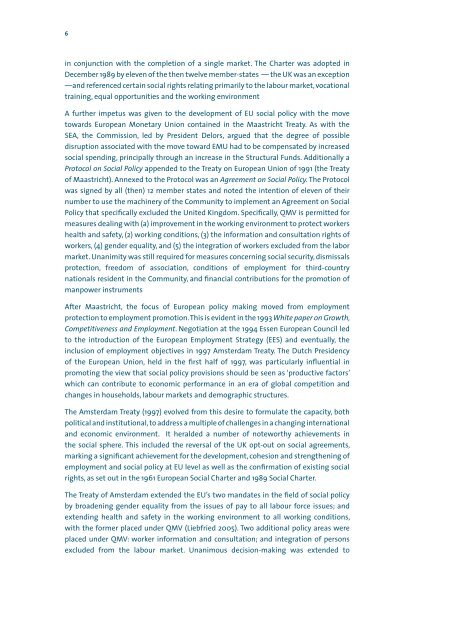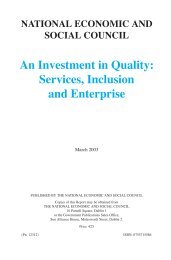4. Perspectives on the Evolution of European Social Policy
4. Perspectives on the Evolution of European Social Policy
4. Perspectives on the Evolution of European Social Policy
- No tags were found...
Create successful ePaper yourself
Turn your PDF publications into a flip-book with our unique Google optimized e-Paper software.
in c<strong>on</strong>juncti<strong>on</strong> with <strong>the</strong> completi<strong>on</strong> <strong>of</strong> a single market. The Charter was adopted inDecember 1989 by eleven <strong>of</strong> <strong>the</strong> <strong>the</strong>n twelve member-states — <strong>the</strong> UK was an excepti<strong>on</strong>—and referenced certain social rights relating primarily to <strong>the</strong> labour market, vocati<strong>on</strong>altraining, equal opportunities and <strong>the</strong> working envir<strong>on</strong>mentA fur<strong>the</strong>r impetus was given to <strong>the</strong> development <strong>of</strong> EU social policy with <strong>the</strong> movetowards <strong>European</strong> M<strong>on</strong>etary Uni<strong>on</strong> c<strong>on</strong>tained in <strong>the</strong> Maastricht Treaty. As with <strong>the</strong>SEA, <strong>the</strong> Commissi<strong>on</strong>, led by President Delors, argued that <strong>the</strong> degree <strong>of</strong> possibledisrupti<strong>on</strong> associated with <strong>the</strong> move toward EMU had to be compensated by increasedsocial spending, principally through an increase in <strong>the</strong> Structural Funds. Additi<strong>on</strong>ally aProtocol <strong>on</strong> <strong>Social</strong> <strong>Policy</strong> appended to <strong>the</strong> Treaty <strong>on</strong> <strong>European</strong> Uni<strong>on</strong> <strong>of</strong> 1991 (<strong>the</strong> Treaty<strong>of</strong> Maastricht). Annexed to <strong>the</strong> Protocol was an Agreement <strong>on</strong> <strong>Social</strong> <strong>Policy</strong>. The Protocolwas signed by all (<strong>the</strong>n) 12 member states and noted <strong>the</strong> intenti<strong>on</strong> <strong>of</strong> eleven <strong>of</strong> <strong>the</strong>irnumber to use <strong>the</strong> machinery <strong>of</strong> <strong>the</strong> Community to implement an Agreement <strong>on</strong> <strong>Social</strong><strong>Policy</strong> that specifically excluded <strong>the</strong> United Kingdom. Specifically, QMV is permitted formeasures dealing with (a) improvement in <strong>the</strong> working envir<strong>on</strong>ment to protect workershealth and safety, (2) working c<strong>on</strong>diti<strong>on</strong>s, (3) <strong>the</strong> informati<strong>on</strong> and c<strong>on</strong>sultati<strong>on</strong> rights <strong>of</strong>workers, (4) gender equality, and (5) <strong>the</strong> integrati<strong>on</strong> <strong>of</strong> workers excluded from <strong>the</strong> labormarket. Unanimity was still required for measures c<strong>on</strong>cerning social security, dismissalsprotecti<strong>on</strong>, freedom <strong>of</strong> associati<strong>on</strong>, c<strong>on</strong>diti<strong>on</strong>s <strong>of</strong> employment for third-countrynati<strong>on</strong>als resident in <strong>the</strong> Community, and financial c<strong>on</strong>tributi<strong>on</strong>s for <strong>the</strong> promoti<strong>on</strong> <strong>of</strong>manpower instrumentsAfter Maastricht, <strong>the</strong> focus <strong>of</strong> <strong>European</strong> policy making moved from employmentprotecti<strong>on</strong> to employment promoti<strong>on</strong>. This is evident in <strong>the</strong> 1993 White paper <strong>on</strong> Growth,Competitiveness and Employment. Negotiati<strong>on</strong> at <strong>the</strong> 1994 Essen <strong>European</strong> Council ledto <strong>the</strong> introducti<strong>on</strong> <strong>of</strong> <strong>the</strong> <strong>European</strong> Employment Strategy (EES) and eventually, <strong>the</strong>inclusi<strong>on</strong> <strong>of</strong> employment objectives in 1997 Amsterdam Treaty. The Dutch Presidency<strong>of</strong> <strong>the</strong> <strong>European</strong> Uni<strong>on</strong>, held in <strong>the</strong> first half <strong>of</strong> 1997, was particularly influential inpromoting <strong>the</strong> view that social policy provisi<strong>on</strong>s should be seen as ‘productive factors’which can c<strong>on</strong>tribute to ec<strong>on</strong>omic performance in an era <strong>of</strong> global competiti<strong>on</strong> andchanges in households, labour markets and demographic structures.The Amsterdam Treaty (1997) evolved from this desire to formulate <strong>the</strong> capacity, bothpolitical and instituti<strong>on</strong>al, to address a multiple <strong>of</strong> challenges in a changing internati<strong>on</strong>aland ec<strong>on</strong>omic envir<strong>on</strong>ment. It heralded a number <strong>of</strong> noteworthy achievements in<strong>the</strong> social sphere. This included <strong>the</strong> reversal <strong>of</strong> <strong>the</strong> UK opt-out <strong>on</strong> social agreements,marking a significant achievement for <strong>the</strong> development, cohesi<strong>on</strong> and streng<strong>the</strong>ning <strong>of</strong>employment and social policy at EU level as well as <strong>the</strong> c<strong>on</strong>firmati<strong>on</strong> <strong>of</strong> existing socialrights, as set out in <strong>the</strong> 1961 <strong>European</strong> <strong>Social</strong> Charter and 1989 <strong>Social</strong> Charter.The Treaty <strong>of</strong> Amsterdam extended <strong>the</strong> EU’s two mandates in <strong>the</strong> field <strong>of</strong> social policyby broadening gender equality from <strong>the</strong> issues <strong>of</strong> pay to all labour force issues; andextending health and safety in <strong>the</strong> working envir<strong>on</strong>ment to all working c<strong>on</strong>diti<strong>on</strong>s,with <strong>the</strong> former placed under QMV (Liebfried 2005). Two additi<strong>on</strong>al policy areas wereplaced under QMV: worker informati<strong>on</strong> and c<strong>on</strong>sultati<strong>on</strong>; and integrati<strong>on</strong> <strong>of</strong> pers<strong>on</strong>sexcluded from <strong>the</strong> labour market. Unanimous decisi<strong>on</strong>-making was extended to
















